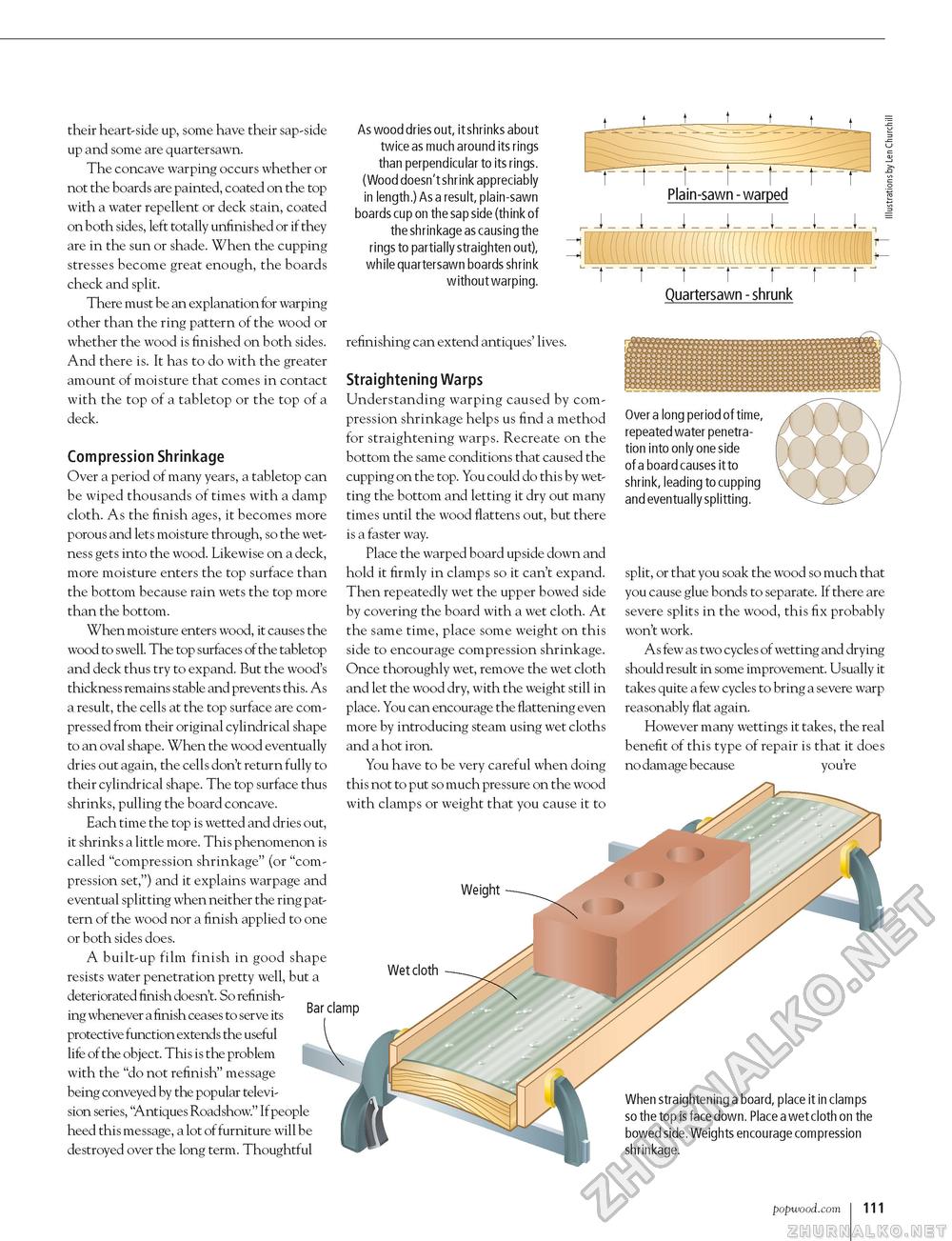Popular Woodworking 2004-10 № 143, страница 114
their heart-side up, some have their sap-side up and some are quartersawn. The concave warping occurs whether or not the boards are painted, coated on the top with a water repellent or deck stain, coated on both sides, left totally unfinished or if they are in the sun or shade. When the cupping stresses become great enough, the boards check and split. There must be an explanation for warping other than the ring pattern of the wood or whether the wood is finished on both sides. And there is. It has to do with the greater amount of moisture that comes in contact with the top of a tabletop or the top of a deck. Compression Shrinkage Over a period of many years, a tabletop can be wiped thousands of times with a damp cloth. As the finish ages, it becomes more porous and lets moisture through, so the wetness gets into the wood. Likewise on a deck, more moisture enters the top surface than the bottom because rain wets the top more than the bottom. When moisture enters wood, it causes the wood to swell. The top surfaces of the tabletop and deck thus try to expand. But the wood's thickness remains stable and prevents this. As a result, the cells at the top surface are compressed from their original cylindrical shape to an oval shape. When the wood eventually dries out again, the cells don't return fully to their cylindrical shape. The top surface thus shrinks, pulling the board concave. Each time the top is wetted and dries out, it shrinks a little more. This phenomenon is called "compression shrinkage" (or "compression set,") and it explains warpage and eventual splitting when neither the ring pattern of the wood nor a finish applied to one or both sides does. A built-up film finish in good shape resists water penetration pretty well, but a deteriorated finish doesn't. So refinish-ing whenever a finish ceases to serve its protective function extends the useful life of the object. This is the problem with the "do not refinish" message being conveyed by the popular television series, "Antiques Roadshow." If people heed this message, a lot of furniture will be destroyed over the long term. Thoughtful As wood dries out, it shrinks about twice as much around its rings than perpendicular to its rings. (Wood doesn't shrink appreciably in length.) As a result, plain-sawn boards cup on the sap side (think of the shrinkage as causing the rings to partially straighten out), while quartersawn boards shrink without warping. ffl Plain-sawn - warped ■ T~~r Quartersawn - shrunk refinishing can extend antiques' lives. Straightening Warps Understanding warping caused by compression shrinkage helps us find a method for straightening warps. Recreate on the bottom the same conditions that caused the cupping on the top. You could do this by wetting the bottom and letting it dry out many times until the wood flattens out, but there is a faster way. Place the warped board upside down and hold it firmly in clamps so it can't expand. Then repeatedly wet the upper bowed side by covering the board with a wet cloth. At the same time, place some weight on this side to encourage compression shrinkage. Once thoroughly wet, remove the wet cloth and let the wood dry, with the weight still in place. You can encourage the flattening even more by introducing steam using wet cloths and a hot iron. You have to be very careful when doing this not to put so much pressure on the wood with clamps or weight that you cause it to Over a long period of time, repeated water penetration into only one side of a board causes it to shrink, leading to cupping and eventually splitting. split, or that you soak the wood so much that you cause glue bonds to separate. If there are severe splits in the wood, this fix probably won't work. As few as two cycles of wetting and drying should result in some improvement. Usually it takes quite a few cycles to bring a severe warp reasonably flat again. However many wettings it takes, the real benefit of this type of repair is that it does no damage because you're Bar clamp When straightening a board, place it in clamps so the top is face down. Place a wet cloth on the bowed side. Weights encourage compression shrinkage. popwood.com 111 |








